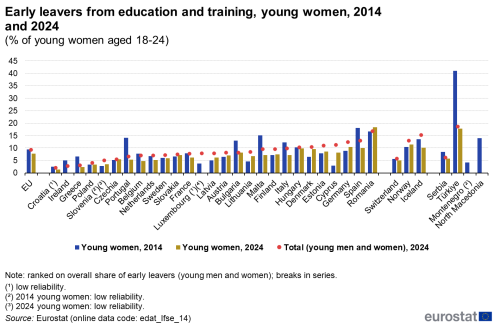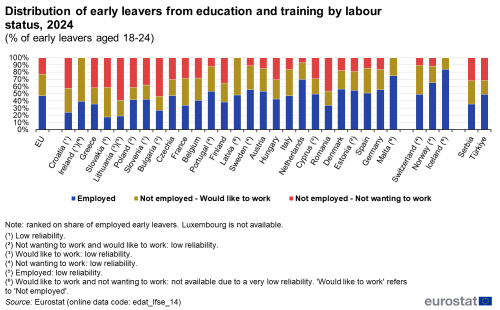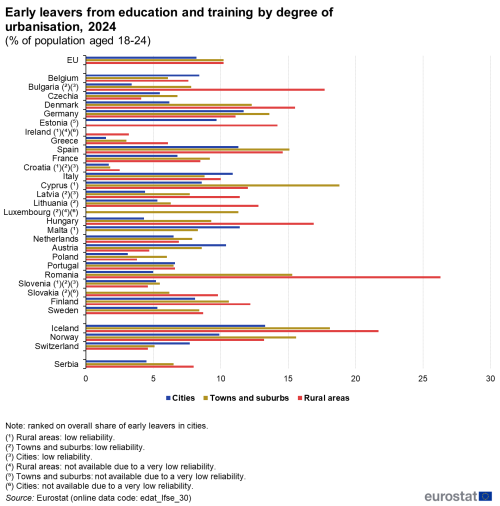Data extracted in May 2025.
Planned article update: May 2026.
Highlights
Early leavers from education and training, 2024
This article presents statistics on early leavers from education and training in the European Union (EU) and forms part of the online publication Education and training in the EU - facts and figures. Early leavers are defined as individuals aged 18-24 who have completed at most a lower secondary education and were not in further education or training during the four weeks preceding the labour force survey (LFS). It is important to follow the developments of this group, as early leavers from education and training can face challenges when trying to get established in the labour market. Education has become an increasingly important factor for employers when hiring employees. Leaving education early can also have significant consequences for both individuals and society in the long term.
The EU has set an EU-level target stipulating that the share of early leavers from education and training should be less than 9% by 2030. In 2024, an average of 9.3% early leavers from education and training was identified within the EU. However, there were differences between EU countries, with several having already met the EU-level target for 2030. The results also varied between women and men as well as between young people living in areas with different degrees of urbanisation, both within one country and across different EU countries.
Early leavers from education and training – today and 10 years ago
In 2024, an average of 9.3% of young people aged 18-24 in the EU were early leavers from education and training. Across EU countries, the proportion of early leavers in 2024 ranged from 2.0% in Croatia to 16.8% in Romania (see Figure 1). The EU countries with the lowest proportion of early leavers were Croatia, Ireland, Greece and Poland where the share was below 5%. The highest shares were found in Romania (16.8%), followed by Spain (13.0%) and Germany (12.4%). There were thus large differences between the EU countries, however, 17 countries have already reached the EU-level target for 2030, i.e. their share of early leavers from education and training is already less than 9%.
The overall share of early leavers from education and training fell in the EU between 2014 and 2024 by 1.8 percentage points (pp). Among EU countries, the largest reductions between 2014 and 2024 were observed in Portugal (-10.7 pp) and Spain (-8.9 pp). There are also 10 EU countries that saw increases in the share of early leavers; among these, the countries with increases of more than 2.0 pp were Denmark, Lithuania, Germany and Cyprus.
A higher proportion of early leavers are men – analysis by sex
The proportion of early leavers from education and training was 3.2 pp higher for young men (10.9%) than for young women (7.7%) in the EU in 2024 (see Figure 2). Nearly all EU countries reported a higher proportion of early leavers for young men than for young women, except Romania. Particularly large differences were observed in Cyprus (6.3 pp), Spain (5.8 pp), Italy (5.1 pp), Estonia (4.7 pp), Malta (4.6 pp), Belgium (4.4 pp) and Finland (4.4 pp). In contrast, the share of early leavers was about the same for young women and young men in Czechia and Bulgaria (both -0.1 pp).
Between 2014 and 2024, most EU countries reported a fall in the proportion of early leavers among young men (see Figure 3). The largest decreases compared with 2014 were in Portugal (-12.7 pp) and Spain (-9.8 pp). Conversely, 4 countries reported increases greater than 2.0 pp: Luxembourg, Lithuania, Cyprus and Germany.
Among young women, a similar situation was observed (see Figure 4). Portugal recorded the largest fall in the proportion of early school leavers, down 8.8 pp between 2014 and 2024 for young women, followed by Spain (-8.1 pp) and Malta (-8.0%). However, 3 EU countries reported the proportion of young women among early leavers in 2024 as being more than 2.0 pp higher than in 2014: Lithuania (2.2 pp), Denmark (3.2 pp) and Cyprus (5.3 pp).

Source: Eurostat (edat_lfse_14)

Source: Eurostat (edat_lfse_14)
Do early leavers have a job? Analysis by the individual’s labour status
Early leavers from education and training may face challenges when trying to enter the labour market. Figure 5 gives an analysis of whether early leavers are employed or not, ranking the EU countries according to the share of employed early leavers. In 2024 the distribution between different labour market outcomes was as follows: 47.3% of all early leavers were in employment, while 30.1% were not employed but wanted to work, and the remaining 22.6% were not employed and did not want to work. In relation to the whole population aged 18-24, this corresponded to 4.4% of young people who were employed early leavers, 2.8% who were early leavers, not employed and wanting to work, and 2.1% who were early leavers, not employed and not wanting to work.

Source: Eurostat (edat_lfse_14)
In 2024, only 9 EU countries reported 50% or more early leavers who were employed: Malta, Netherlands, Denmark, Sweden, Germany, Estonia, Austria, Portugal and Spain. In the majority of countries, early leavers were predominately not in employment, with the highest shares of early leavers not employed found in Bulgaria (72.0%), Croatia (80.0%), Lithuania (81.0%) and Slovakia (82.7%).
Does it matter where you live? Analysis by degree of urbanisation
Figure 6 presents an analysis of the proportion of early leavers from education and training according to the degree of urbanisation, with regions classified as cities, towns and suburbs, or rural areas. In 2024, the lowest proportion of early leavers in the EU was reported in cities (8.2%). Thus, the target for 2030, namely that the share of early leavers should be less than 9%, is already achieved among youths who live in cities. In the towns and suburbs of the EU, the proportion of early leavers amounted to 10.2%, which is also the same level as in rural areas.

Source: Eurostat (edat_lfse_30)
Source data for tables and graphs
Data sources
The EU labour force survey (LFS) provides statistics on early leavers. The EU-LFS is documented in this background article which provides information on the scope of the data, its legal basis, the methodology employed, as well as related concepts and definitions. Data on early leavers are calculated as annual averages of quarterly data.
Classification for education
The International standard classification of education (ISCED) is the basis for international education statistics, describing different levels of education; it was first developed in 1976 by UNESCO and revised in 1997 and again in 2011. ISCED 2011 differentiates 9 levels of education: early childhood education (level 0); primary education (level 1); lower secondary education (level 2); upper secondary education (level 3); post-secondary non-tertiary education (level 4); short-cycle tertiary education (level 5); bachelor’s or equivalent level (level 6); master’s or equivalent level (level 7); doctoral or equivalent level (level 8).
The first EU-LFS results based on ISCED 2011 were published in 2015 starting with data for 2014 (the reference period). Data up to 2013 were based on ISCED 1997.
Key concepts
Early leavers from education and training denotes the percentage of the population aged 18-24 having attained at most a lower secondary education and not being involved in further education or training.
- The numerator of the indicator refers to persons aged 18-24 who meet the following two conditions: (a) the highest level of education or training they have completed is ISCED 2011 levels 0, 1 or 2 (ISCED 1997 levels 0, 1, 2 or 3C short); and (b) they have not received any education or training (in other words neither formal nor non-formal) in the four weeks preceding the survey.
- The denominator is the total population of the same age group, excluding respondents who did not answer the questions ‘highest level of education or training successfully completed’ and ‘participation in education and training’.
Tables in this article use the following notation: ‘:’ not available, confidential or unreliable value.
Context
Tackling early leavers
Most Europeans spend significantly more time in education than the legal minimum requirement. This reflects the choice to enrol in higher education, as well as increased enrolment in pre-primary education and wider participation in lifelong learning initiatives. Nevertheless, around 1 in 10 young adults leave school or training early and this has an impact on the individuals, society and economies.
EEA 2030 strategic framework
A Resolution on a strategic framework for European cooperation in education and training towards the European Education Area and beyond (known as EEA 2030) was agreed by the Council in February 2021. It outlines five strategic priorities for the period 2021-2030: improving quality, equity, inclusion and success for all in education and training; making lifelong learning and mobility a reality for all; enhancing competences and motivation in the education profession; reinforcing European higher education; and supporting the green and digital transitions in and through education and training. To monitor progress, 7 EU-level targets, i.e. reference levels of European average performance, have been defined, including that the share of early leavers from education and training should be less than 9% by 2030.
The indicator early leavers from education and training is also used to reflect the principles of the European Pillar of Social Rights and to monitor the Sustainable Development Goals.
Already in January 2011, the European Commission adopted a Communication entitled ‘Tackling early school leaving: a key contribution to the Europe 2020 agenda’ (COM(2011) 18 final). This Communication included information about why youths decide to leave school early. It was observed that the reasons why young people leave education and training early are highly individual, though some common reasons have been identified: for example, the individuals have learning difficulties; a lack of motivation, guidance or support; social factors. Further, the Communication gave an overview of existing and planned measures to tackle this challenge across EU countries.
In 2014, the Education, Audiovisual and Culture Executive Agency and the European Centre for the Development of Vocational Training (CEDEFOP) jointly released a report on Tackling early leaving from education and training in Europe: strategies, policies and measures. This report provides detailed information about the challenges associated with early leavers and how these should be tackled. CEDEFOP also provided an online VET toolkit for tackling early leaving which offers support to policy makers and practitioners in order to design and implement policies to prevent and remedy early leaving from education and training.
Explore further
Other articles
Database
- Education and training outcomes (educ_outc)
- Transition from education to work (edatt)
- Early leavers from education and training (edatt1)
- Transition from education to work (edatt)
- Education and training outcomes (educ_outc)
Thematic section
Selected datasets
Methodology
Metadata
- Educational attainment level and transition from education to work (reference metadata – edat1_esms)
Manuals and other methodological information


